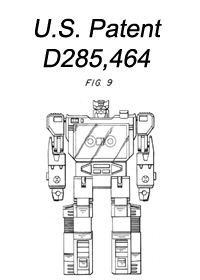The bulk of the Decepticons included in the first series of Generation 1 in 1984 were carry-overs from Takara’s Microman: Microchange series, and the Cassette master Soundwave was no exception. Transforming into a super-hi-tech Walkman-style portable Microcassette player, Soundwave actually lacks any way to “hear” the mysterious contents of his Cassette minions.
Soundwave, like many early Transformers toys, originated in the Takara Microman: Microchange line. He was originally released as MC10 Cassette Man, and included the Microchange equivalent of Rumble, as well as headphones with foam earpieces and a microphone boom, as well as a rubber cord that connected the headphones to Soundwave’s shoulder hole. This version can be distinguished by the name “Cassette Man” molded on the bottom of his tape door, molded in place of Soundwave’s plain stripes. Soundwave was invented by Satoshi Koizumi and his US Patent, titled Reconfigurable toy cassette (aka Transformers G1 Soundwave) was filed on April 4, 1984 (U.S. Patent No. USD285464 S). Soundwave’s alternate mode is a rather generic cassette player. While it looks like a scaled-down Walkman, the specific designation on his Cassettes indicates that he would be an actual-scale Microcassette player, possibly inspired by the Olympus SR-11, which offered similar functionality. He includes details such as a movable chrome volume dial, slidable power switch, a belt clip, non-functional playback buttons, and even a mechanical eject button that opens his tape door so Mini-Cassettes may be placed inside. The detail continues throughout his decoration, such as a stickered record light, tape counter (bearing the digits “010” in homage to his Microchange series number), and a molded tape reel gauge on the inside of the clear plastic cassette door. Disappointingly, the Transformers version omitted the headset and microphone accessories, and since Walkman-type cassette players typically lacked internal speakers, Soundwave lacks any visible means of audio playback. Soundwave’s transformation is rather straightforward, creating a rather blocky robot out of the block of an alternate mode. However, the bulk of his alternate mode yields a robot that towers over all the other 1984 releases. His die-cast metal toes help him keep steady footing, though his reverse-bending knees can cause some instability if they loosen with playwear. His angular, pointy facial features look inherently evil, and it is no coincidence that the Decepticon symbol bears more than a passing resemblance to him. His battery compartment door can be slid off to reveal his two weapons disguised as AA batteries. One of these may be extended and used as a missile launcher for his chrome missiles, and the other is simply molded to look like a magazine of smaller rockets. A hole on his shoulder allows a weapon to be pegged in, typically the smaller non-firing rocket launcher. Soundwave seems a quite robust and sturdy design due to his thick, boxy appendages and metal-pinned hinges, but he is very prone to breakage: the cassette door mechanism, as well as the door itself are quite frail. A number of catastrophic breakages can occur from internal catches preventing the door from opening or staying closed, to the door being entirely torn off its hinges. Like most Transformers of this era, Soundwave has a number of casting variations. The two primary variations are the closed- and open-wrist versions. Earlier production used a fist piece that was solid and smooth from the hand-hole to the silver forearm, while later issues had a large slot just below the forearm. A number of other less obvious variations also exist. Soundwave’s popularity granted him a large variety of releases.
In the US, he was available in 1984, packed with Buzzsaw This set was available again in 1985 and 1986, with a rubsign replacing the traditional Decepticon symbol on his tape door/chest (and another on Buzzsaw's stickered side).
In Europe, Soundwave was released in the UK in 1984, identical to the US version, and available in the UK and continental Europe in 1985 (excluding Italy), now including the rubsigns. Soundwave was released Japan in 1985, though the Japanese version came packed with Rumble instead of Buzzsaw, and included the headset accessories from the Microchange Cassette Man, as well as a clear case for Rumble. He was also available in the 1985 in the VSY giftset, lacking the headset accessories, but packed with Frenzy (including tape case), and facing off against an unaltered Grimlock. He was reissued in Japan in 2003 as part of The Transformers Collection with some minor molding and sticker modifications, and including Rumble. He was reissued in the U.S. (this time including Laserbeak and ”Battle” Ravage) in 2007 as part of the Toys ’R’ Us Commemorative Edition line, albeit in Classics style packaging. This version had several modifications, the most notable of which was the remolded tape door molded in crystal clear plastic, that could hold two cassettes at the same time, by means of the door protruding from the surface of Soundwave’s chest. He received a second Japanese reissue in 2007 during the Transformers Encore line, having his single-tape, dark plastic chest once again, and now including Laserbeak. He was reissued AGAIN again in the U.S. as a San Deigo Comic-Con or Hasbro Toy Shop exclusive packaged with Laserbeak, Ravage, Buzzsaw, and Ratbat in 2009. This version also had the darker-plastic, single-tape door. Soundwave’s mold was first used in Takara’s 1983 Microchange MC10 Cassette Man. He was retooled with a double tape deck in 1987 to produce Soundblaster for Japanese release. The single-tape version was redecoed in 2013 to produce Linkin Park Soundwave: Special Edition, an all-gold version with no stickers.Origins
Description
Collector Notes
Variants
Availability
Redecos & Retools























